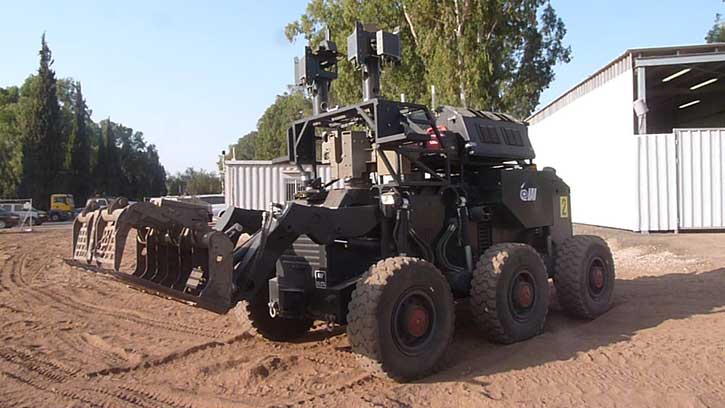Israel Aerospace Industries (IAI) has completed the development of an Autonomous IEDs Detection and Neutralization System. The robot will soon be transferred to a customer for operational trials, testing, and evaluation.
The new robotic engineering scout is a member of IAI’s Sahar family of route clearing and counter-IED robots. The original Sahar (shown in the video below) was based on a Bobcat commercial off the shelf (COTS) vehicle and implemented various sensors and tools to operate autonomously on most tasks. The new version utilizes IAI’s 6×6 Robattle platform, a rugged platform specially designed for robotic missions.
“The SAHAR system integrates advanced sensors and autonomous navigation techniques to offer an end to end solution for clearing threatened routes, operations that were done heretofore by troops, with significant danger to their lives”. Meir Shabtai, General Manager, Robotic Systems Division said. The robot integrates multiple sensors for the detection and neutralization of mines and Improvised Explosive Devices (IEDs). The system combines a number of payloads of different types for detection of explosive devices on and under the surface and engineering capabilities for neutralizing them. These sensors enable the Sahar to detect IEDs placed and hidden in complex areas, engage and remove them as necessary using the blade installed on the vehicle. The system operation, maneuver, and detection are done autonomously, thus minimizing risk to human soldiers.
Each system in the Sahar family utilizes IAI’s robotic kit and adapted to meet the customer needs. It includes the robotic platform, detection payloads, and control systems. Utilization of the robotic kit enables faster integration, efficient learning curve, and mission execution. The system may operate in any terrain and has a precision operation system that generates a real image of the arena.


Under a separate program, IAI will convert Caterpillar Dozers into autonomous dozers that will be commissioned for complex engineering tasks in threatened areas. The contract was awarded after years of evaluation by the Israel Defense Forces (IDF) and maturation of the robotic dozer concept.
The new autonomous system integrated with the dozer provides the vehicle various degrees of autonomy including movement and earthworks for a range of applications, including construction, obstacle breaching, demolition and preparation and construction of defensive positions. The system is fitted with object detection and avoidance capabilities and is designed to work under all weather and visibility conditions.




















